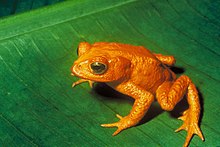
A true toad is any member of the family Bufonidae, in the order Anura. This is the only family of anurans in which all members are known as toads, although some may be called frogs. The bufonids now comprise more than 35 genera, Bufo being the best known.

The Gulf Coast toad is a species of toad native to eastern and southeastern Mexico and Central America as far south as Costa Rica.

Incilius bocourti is a species of toad in the family Bufonidae. It is found in southwestern Guatemala and in Chiapas in the adjacent Mexico. Its phylogenetic position is uncertain; it might not to belong to this genus, being the sister taxon of Anaxyrus instead. It is named after Marie Firmin Bocourt, a French zoologist and artist.

The evergreen toad is a species of toad in the family Bufonidae.

Incilius ibarrai is a species of toad in the family Bufonidae. It is found in the central and southern highlands of Guatemala and adjacent Honduras. The specific name ibarrai honors Jorge Alfonso Ibarra (1921–2000), then-director of the Guatemalan National Natural History Museum.
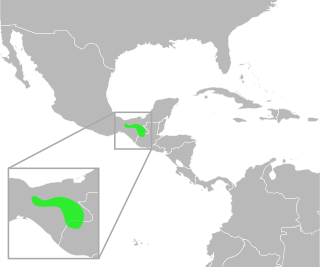
Incilius macrocristatus a species of toad in the family Bufonidae. It is found in Chiapas in southern Mexico and the adjacent Guatemala. Its natural habitats are cloud forests and pine-oak-Liquidambar forests. Breeding takes place in streams. It is a rare species that is threatened by habitat loss caused by agriculture and human settlement, and by water pollution.
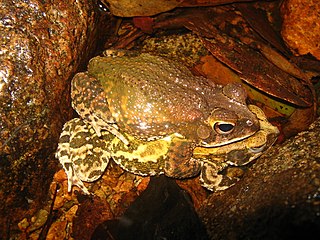
Incilius marmoreus, commonly known as Wiegmann's toad or marbled toad, is a species of toad in the family Bufonidae. It is endemic to Mexico and found along the Pacific coastal plain between northern Sinaloa and Chiapas. There is also an isolated population in the region of Veracruz on the Atlantic coast, and a record from Hidalgo.

Incilius melanochlorus, formerly Bufo melanochlorus, is a mid-sized species of toad with a crested head in the family Bufonidae. It is primarily distinguished by its very long first finger with respect to the other fingers. It is found in southern Nicaragua, in the northern Cordillera Central and on the Atlantic slopes of eastern Costa Rica, and in western Panama.

The pine toad is a species of toad in the family Bufonidae. It is endemic to Mexico and found on the Central Mexican Plateau.

Incilius pisinnus is a species of "true" toads in the family Bufonidae. It is endemic to Mexico and known from the Tepalcatepec Valley in Michoacán. Prior to its description in 2005, it was mixed with Incilius coccifer and Incilius cycladen. The specific name pisinnus, from the Latin word for "small", refers to the comparatively small size of this species among its close relatives.

Incilius porteri is a species of toads in the family Bufonidae. It is endemic to the Montañas de Comayagua region, Honduras. Its natural habitat is tropical moist montane forests. It is likely threatened by habitat loss and chytridiomycosis.
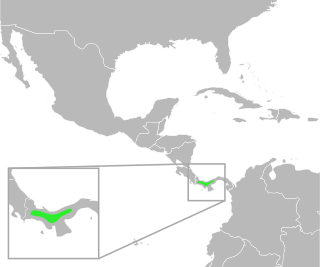
Incilius signifer is a species of toads in the family Bufonidae. It is endemic to Panama and known from the Pacific Coast to 800 m (2,600 ft) asl, west of the Canal Zone. Prior to its description in 2005, it was mixed with Incilius coccifer. Its natural habitats are tropical dry forests. It tolerates habitat modification but could be threatened by severe habitat modification.

Incilius spiculatus is a species of toad in the family Bufonidae. It is endemic to Oaxaca, Mexico, and known from the northern slopes of the Sierra de Juárez and the adjacent Sierra Mixe. Its natural habitats are cloud forests and lowland rainforests. It breeds in streams. It is threatened by habitat loss.

Sclerophrys is a genus of "true toads", family Bufonidae, native to Africa and the southern Arabian Peninsula. Originally, all of these species were classified in the genus Bufo. The genus, originally named Amietophrynus, was split due to large enough taxonomic divergence. Ohler and Dubois showed in 2016 that Sclerophrys capensis Tschudi, 1838 is the same species as Bufo regularis rangeri Hewitt, 1935, the type species of Amietophrynus. Because the former name is older, the implication is that Amietophrynus is a junior synonym of Sclerophrys.
The Latin word Cranopsis has been used to name animal genera of frogs, mollusks and branchiopods. Cranopsis, was used for an anuran, and is a junior homonym of Cranopsis, for a mollusk; and Cranopsis, for a branchiopod. Cranopsis currently describes a mollusk genus in the family Fissurellidae.
Incilius guanacaste is a species of toads in the family Bufonidae. It is endemic to the Cordillera de Guanacaste in northern Costa Rica. The species is only known from the slopes of Miravalles Volcano and Rincón de la Vieja Volcano.
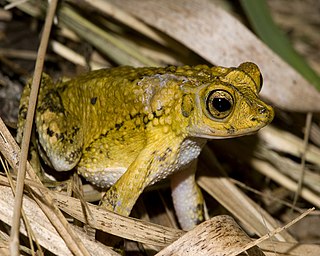
Peltophryne is a genus of true toads in the family Bufonidae, from the Greater Antilles. With ten endemic species, Cuba hosts the highest diversity. Hispaniola has three endemics and Puerto Rico and the Virgin Islands combined have one.
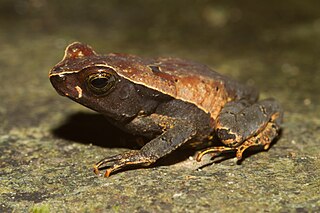
Rhaebo is a genus of true toads, family Bufonidae, from Central and South America. They are distributed from Honduras to northern South America including the Amazonian lowlands. Common name Cope toads has been suggested for them.
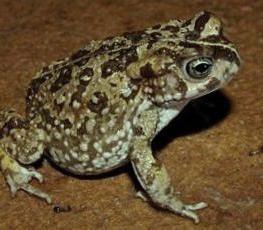
Vandijkophrynus, also known as Van Dijk's toads, are a small genus of true toads, family Bufonidae. They are native to Southern Africa. The name commemorates Eddie Van Dijk, a South African herpetologist.
